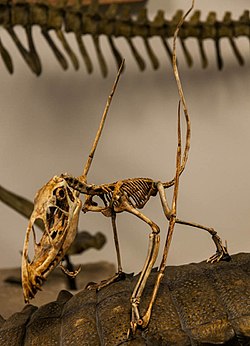Dimorphodon macronyx
|
Dimorphodon Temporal range: Early Jurassic, 195–190 Ma |
|
|---|---|
 |
|
| Mounted skeleton of a Dimorphodon. | |
| Scientific classification | |
| Kingdom: | Animalia |
| Phylum: | Chordata |
| Class: | Reptilia |
| Order: | †Pterosauria |
| Family: | †Dimorphodontidae |
| Subfamily: |
†Dimorphodontinae Seeley, 1870 |
| Genus: |
†Dimorphodon Owen, 1859 |
| Type species | |
|
Dimorphodon macronyx Buckland, 1829 |
|
| Species | |
|
D. macronyx (Buckland, 1829) |
|
D. macronyx (Buckland, 1829)
D. weintraubi Clark et al., 1998
Dimorphodon /daɪˈmɔːrfədɒn/ was a genus of medium-sized pterosaur from the early Jurassic Period. It was named by paleontologist Richard Owen in 1859. Dimorphodon means "two-form tooth", derived from Greek δι/di meaning "two", μορφη/morphe meaning "shape" and οδων/odon meaning "tooth", referring to the fact that it had two distinct types of teeth in its jaws – which is comparatively rare among reptiles.
The body structure of Dimorphodon displays many "primitive" characteristics, such as, according to Owen, a very small brain-pan and proportionally short wings. The first phalanx in its flight finger is only slightly longer than its lower arm. The neck was short but strong and flexible and may have had a membraneous pouch on the underside. The vertebrae had pneumatic foramina, openings through which the air sacks could reach the hollow interior. Dimorphodon had an adult body length of 1 metre (3.3 ft) long, with a 1.45 metre (4.6 ft) wingspan. The tail of Dimorphodon was long and consisted of thirty vertebrae. The first five or six were short and flexible, but the remainder gradually increased in length and were stiffened by elongated vertebral processes. The terminal end of the tail may have borne a Rhamphorhynchus-like tail vane, although no impressions have yet been found in Dimorphodon fossils to confirm this speculation.
Dimorphodon had a large, bulky skull approximately 23 centimetres in length, whose weight was reduced by large openings separated from each other by thin bony partitions. Its structure, reminiscent of the supporting arches of a bridge, prompted Richard Owen to declare that, as far as achieving great strength from light-weight materials was concerned, no vertebra was more economically constructed; Owen saw the vertebrate skull as a combination of four vertebrae modified from the ideal type of the vertebra. The front of the upper jaw had four or five fang-like teeth followed by an indeterminate number of smaller teeth; the maxilla of all exemplars is damaged at the back. The lower jaw had five longer teeth and thirty to forty tiny, flattened pointed teeth, shaped like a lancet. Many depictions give it a speculative puffin-like 'beak' because of similarities between the two animals' skulls.
...
Wikipedia
